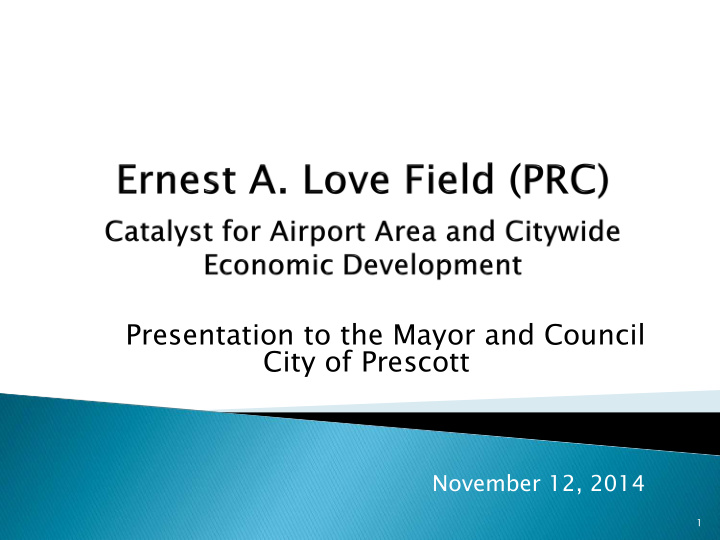



Presentation to the Mayor and Council City of Prescott November 12, 2014 1
‣ Private Sector ad hoc Steering Group - Participants - Purpose - Process ‣ Key Findings ‣ Recommendations and Implementation – Partnerships and Leverage 2
Airp irport rt Are rea ◦ Airport is an underutilized City asset ◦ The future economic success of PRC will be defined by extending and strengthening its main runway ◦ The Airport needs updating and new capital investments to increase its economic development impact ◦ Airport development requires a long term financial commitment of the City of Prescott ◦ The priorities and timing of airport improvements are heavily influenced by FAA policies and decisions ◦ The City has a significant investment in the Airport and to more fully capitalize on that investment, the main runway must be lengthened & strengthened and a new terminal constructed 3
Private Sector ◦ Dr. Frank Ayers – Chancellor, ERAU (Prescott) ◦ Michael Gjede – Brig. Gen., USAF (Ret.) ◦ Kevin Lane – Founding Principal, Lane Brothers and Co. ◦ John Gorden – Real Estate Broker ◦ John Markham – Engineer, Cobham Aerospace Communications ◦ Rick Roberts – Captain, FedEx (Ret.) ◦ David Shingledecker – Vice President and General Manager, General Dynamics Integrated Space System Division (Ret.) ◦ Dr. Robin Sobotta – Chair, Business Dept., ERAU ◦ Alex Vakula – Attorney, The Vakula Law Firm City ◦ Mayor Marlin Kuykendall ◦ Craig McConnell, City Manager ◦ John Cox, Airport Manager ◦ Jeff Burt, Director, DEI - Facilitator 4
Steer teering G g Grou oup P Purpose ◦ Provide an independent perspective on the Airport and Airport Area ◦ Review and contribute to strategic planning presentations to Council (1/14, 2/25, 3/25, 4/22/2014) ◦ Provide feedback on Airport challenges and opportunities (FAA, facilities, and funding) ◦ Engage Airport Area stakeholders including existing businesses, airport tenants, realtors, developers, and key property owners ◦ Evaluate and recommend project priorities for both the Airport Area and Prescott Municipal Airport 5
Pr Proces ess ◦ A group of Prescott citizens (the Steering Group) with interests, knowledge and experience in airports and economic development was convened ◦ The Steering Group met regularly on an ad hoc basis to address selected topics/issues related the Airport and Airport Area ◦ The Group met 23 times, including 8 sessions with Airport Area stakeholders ◦ Conducted a strategic planning SWOT (strengths, weaknesses, opportunities, threats analysis) for the Airport and Airport Area ◦ Reviewed findings of studies oriented to groups not directly affiliated with the City regarding airport and air passenger service perceptions ◦ Summarized discussions to develop Steering Group recommendations for consideration of the Mayor and Council 6
◦ The Airport Area presents significant economic promise due to land availability that is under single ownership, existing and expandable City infrastructure, appropriate zoning, and location ◦ A live, work, and play environment in the Airport Area is the desirable outcome and achievable if these elements are aligned through integrated planning and development of compatible land uses ◦ Significant retail development opportunities will occur in the SR 89 and SR 89A corridors in the next 3 - 4 years due to newly approved housing developments in Prescott and Prescott Valley ◦ The Airport Area can be the Greater Prescott hub for new manufacturing and distribution enterprises ◦ The Airport Area presents an excellent opportunity for the City to be creative in its housing policies and practices with a goal of broadening the mix of types and prices 7
◦ The Airport is an underutilized City asset ◦ The future economic success will be defined by the City’s ability to extend and strengthen the main runway ◦ The Airport needs updating and new capital investment to realize its economic development potential while preserving safety and protection from incompatible land uses ◦ Cognizance of airport improvements and how they relate to air traffic management and noise on the surrounding area must be continuous ◦ Airport development requires a long-term financial commitment of the City, but one that will leverage a ROI of between 8 and 10:1. ◦ The priorities and timing of airport improvements are heavily influenced by and dependent upon federal (FAA) and state (ADOT) policies and decisions 8
9
Action 1 – Provide stable and sustainable funding to implement recommendations Action 2 – Facilitate new commercial venues, particularly along SR 89 and SR 89A, while protecting the Airport from encroachment by incompatible land uses Action 3 – Promote the Airport Area as the City’s primary location for new manufacturers Action 4 – Determine the feasibility of creating a Community Land Trust 10
Action 1a. - Lengthen Runway 3R-21L, structurally strengthen the runway and taxiways, and realign Taxiway Charlie to accommodate larger aircraft (commercial passenger, cargo and others such as U.S. Forest Service), and construct other facilities required for Airport safety facilities and security ($45 million including $3 million local) Action 1b. – Replace the existing Airport Terminal at a location to be determined by a detailed site assessment ($5 million including $2 million local, plus the cost of street access, which is site-dependent) Action 2. - Achieve long-term tenancy for the U.S. Forest Service at PRC as the aerial fire fighting base of choice for Northern Arizona 11
12
Reco commen endations ns Matrix 13
Recommend
More recommend